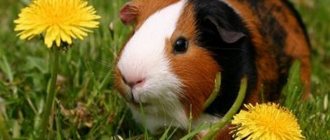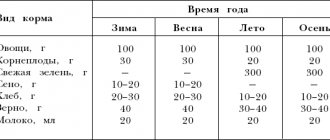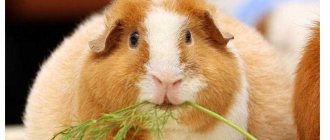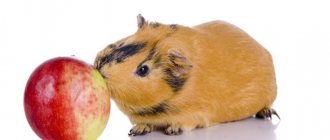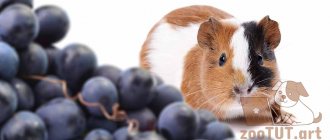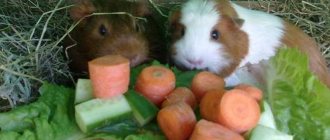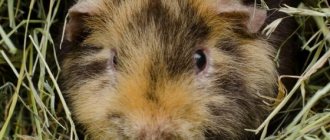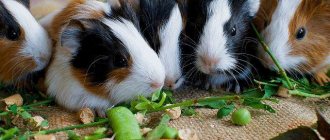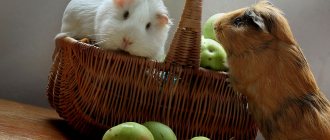Guinea pig seeds: which ones are allowed?
Experts recommend introducing seeds into the pig’s diet.
This will allow you to diversify the menu and treat your pet with a tasty product. Many manufacturers add such seeds to industrial feed. For information about what cereals can be included in a guinea pig’s food, read the article “What cereals can guinea pigs eat.”
Seeds are often included in ready-made food for guinea pigs.
The only contraindication is individual intolerance to the composition of the product.
Basic rules for adding seeds to the diet:
- choose fresh seeds without signs of spoilage;
- They offer only raw ones;
Giving fried food is strictly prohibited.
- before giving a treat, it is necessary to completely clear it of husks;
- The share together with nuts in the total daily portion of food should be 15-20%.
Sunflower seeds are best suited for your pet. With their help, you can even accustom the animal to play tunnels. In second place are pumpkin seeds. Fine flaxseed can be added in small quantities on top of the main feed.
Feeding hemp seeds is not recommended.
Grain nutrition scheme
In practice, guinea pig breeders choose one of two ways to feed their pets:
- grain;
- grain-free.
The grain-based method of nutrition involves the use of ready-made store-bought mixtures: grain or granulated. High-quality products from trusted manufacturers contain a rich set of minerals and other substances vital for the animal. Of course, such food should not constitute the entire daily diet of the pig, but only about 20%. The fruit and vegetable share is also 20%. Another 10% is greens, the rest is hay.
Attention! Good food is not cheap. Cheap analogues are made using simplified technology
They are useless or even harmful to the pig.
Important nuances in this matter:
- Dry food is good for a rodent's teeth, but hard on the stomach. Give it no more than 1 tbsp. l. per day, together with juicy greens or vegetables.
- Dry mixtures are not suitable for dramatically expanding the diet. Introduce them gradually, with 0.5 tsp. for one meal.
- This method of eating is characterized by increased calorie content. It must be combined with the pet's active lifestyle.
What nuts are allowed to give to a rodent?
Opinions are divided regarding nuts. Some owners are of the opinion that this is an unnecessary product, because animals do not feed on them under natural conditions. Others consider the kernels to be an excellent treat, provided they are kept in moderation, but recommend offering them to mobile and active animals.
Whether guinea pigs need nuts in their diet is a controversial issue.
The kernels must also be raw. The most suitable nuts for guinea pigs are walnuts and hazelnuts. Many pets enjoy eating almonds. But there is an opinion that the dose of hydrocyanic acid contained in it may be toxic to the pet.
It is better not to consider pine nuts and peanuts as treats - these varieties contain too high a percentage of fat and can harm the health of the animal. If your pet is lazy and prefers to rest or sit in one place for most of the time, then it is better to exclude any types of nut kernels so as not to provoke obesity in the animal.
For useful information on whether it is possible to treat your pet with baked goods, read the article “Is it possible to give bread to guinea pigs?”
Is it possible to give a guinea pig nuts and seeds 5 (100%) 3 votes >Is it possible to give a walnut to a guinea pig
Composition and calorie content
Pumpkin seeds are a high calorie product. There are about 559 kcal per 100 g of product.
By eating 100 g of seeds, you can provide 115% of the body's daily need for zinc, 141% for magnesium, 80% for iron, and 33% for potassium, which is so necessary for the heart.
Phytosterols. 523 mg (951% of RDA). Of these: campesterol. 19 mg (34.5%), beta-sitosterol. 2.6 mg (6.5%), stigmasterol. 6.8 mg (19%), spinasterol. 112 mg (204%), delta-7-avenasterol. 72 mg (131%), delta-7-stigmasterol. 20 mg (36%), delta-7,25-stigmastadienol. 106 mg (192%), delta-7,22,25-stigmastatrienol. 151 mg (274%).
Sources:
https://homkin.ru/morskie-svinki/pitanie-morskih-svinok/semechki-i-orehi.html https://homjakam.ru/morskaya-svinka/pitanie-svinok/semechki https://zoomservice.ru/ kroliki-i-morskie-svinki/mozhno-li-morskim-svinkam-tykvennye-semechki.html https://www.ayzdorov.ru/tvtravnik_tikvenie_semechki.php
What foods can you feed guinea pigs?
Even experienced livestock breeders ask questions: what to feed their pet, whether it is possible to give certain products. Before getting a guinea pig, you should find out which foods will benefit the animal and which may harm its health. A guinea pig's daily menu should include vegetables, fruits, berries and cereals. Many vegetables and fruits can even be offered to your pet along with the peel. It is important to remember that not all foods that guinea pigs eat are equally beneficial for them. What rodents can eat and what they cannot feed a guinea pig is discussed in this article.
Can guinea pigs have radishes?
It is permissible to use only radish tops. The root vegetable contains essential oils that can cause irritation to the mucous membranes and respiratory tract of the animal. The vegetable also causes bloating. Therefore, it is not recommended to give radishes to pigs.
Can guinea pigs eat celery?
Celery can be given in any form - stems, leaves, roots. This vegetable is included in many dry food for rodents. Celery is enriched with vitamins B, PP, E, C, A and contains phosphorus, zinc, potassium, calcium, iron and magnesium. Before eating, celery must be washed thoroughly, especially the root.
Can guinea pigs eat tomatoes?
Ripe fruits can be included in the food. Tomatoes are well absorbed by animals and contain vitamin C and carotene, which are beneficial for their body. Green tomatoes contain solanine, which can negatively affect your pet’s health.
Too many tomatoes in an animal's menu can cause loose stools.
Can guinea pigs eat cabbage?
Cabbage can be included in the animal's diet. Cabbage contains many vitamins and other substances necessary for pigs:
- ascorbic acid; B vitamins; vitamins of the PP group; folic acid; sulfur; calcium; potassium; phosphorus; amino acids; microelements.
The vegetable is able to keep the animal’s fur in excellent condition and strengthen its immunity. The top dried leaves should be given. It is preferable to feed guinea pigs Chinese cabbage and broccoli. White cabbage can cause bloating.
Can guinea pigs eat potatoes?
Green and sprouted potatoes are contraindicated for guinea pigs. Raw vegetables can be given occasionally, cut into small pieces. Boiled potatoes can be offered to your pet separately or added to grains and other foods.
The vegetable contains solanine, which can harm the health of the animal if the pet eats too many potatoes. The pig will become passive and catch cold quickly.
Can guinea pigs eat beets?
Beetroot contains many substances useful for animals: vitamins C, A and B, potassium, magnesium, phosphorus, iron. In excess, the vegetable contains fiber, so it acts on the animal’s body as a laxative. Store-bought root vegetables may contain nitrates, which are very harmful to the small body of guinea pigs. It is better to offer your pet homemade crops. The composition also contains a large amount of oxalic acid, so it is better to limit the consumption of this product.
It is recommended to give beets starting from 2 months; they are especially useful in winter and spring, when there are no fresh vegetables. The daily dose should not exceed 200 g, and it is better to exclude beets from the diet of pregnant and lactating pigs so as not to provoke an upset stomach. Beets turn stool and urine red, so if your animal has eaten them, don’t be alarmed by such changes.
Can guinea pigs eat pumpkin?
Pigs can be given all varieties of pumpkin that humans eat. For the digestion of herbivorous animals, such a product will be familiar and useful. Pumpkin contains vitamin C, calcium and phosphorus necessary for rodents. It should be borne in mind that this low-calorie vegetable will not be able to saturate the pig completely, so it is better to give pumpkin to guinea pigs as a treat.
Can guinea pigs eat bell pepper?
Another storehouse of ascorbic acid is bell pepper. Before use, the vegetable must be thoroughly washed and chopped, and the seeds removed. It is better to give the product together with dry food.
Green peppers containing solanine should not be given to animals, as should peppers in the form of hot seasonings. Spicy foods will damage the mucous membranes.
Can guinea pigs eat cucumber?
Cucumbers don't have as many nutrients as other vegetables. You can offer your pet a cucumber. The vegetable can harm your pet's health by causing digestive problems only if consumed in large quantities.
Can guinea pigs eat zucchini?
Zucchini is suitable for the diet of guinea pigs. They contain small amounts of vitamin C, calcium and phosphorus. It is better to prefer young vegetables; they can be given along with the peel, cut into crowbars.
General feeding rules
The recommended daily ratio of all types of food looks like this:
- dry food – 5-10% (no more than a tablespoon);
- juicy food – 30%;
- hay – 60%.
If there is no dry food on the menu, an adult pig should eat approximately 150 g of vegetables per day. She is served vegetables every day, and is occasionally pampered with berries and fruits. Vegetable dishes must be supplemented with leafy greens, which compensate for the lack of vitamins.
Do not keep your rodent on a mono-diet, feeding it only carrots or beets: this will cause health problems. It’s great if there are different products on his table every day: parsley will be replaced by dill/basil, and celery by carrots/zucchini. A typical daily diet consists of three types of vegetables and herbs.
Do not forget to establish an uninterrupted supply of hay (especially during the cold period): the guinea pig chews it constantly, without limiting itself in volume. Hay normalizes digestion and is necessary for proper grinding of teeth.
Legume and legume-cereal hay is considered the most valuable. The rodent will also thank you for the vitamin herbs (nettle, alfalfa and clover) that you will prepare in the summer. These plants will be an excellent feed for growing and pregnant animals.
What branches can be given to guinea pigs without fear?
In order for your guinea pig to live as long as possible, you need to monitor the quality of its diet. Unfortunately, sad statistics say that most often pigs die due to problems with the gastrointestinal tract. Therefore, it is necessary to think through her nutrition carefully.
Your pet should eat a balanced diet and regularly. If a rodent is not fed for at least a day or more, it will die of starvation. Exhaustion begins immediately. Therefore, you should never skip meals. The pig should be fed the foods it would eat in the wild. Many owners, having this cute animal at home, do not know how and what to feed the rodent properly.
The ancestors of guinea pigs ate simple food in the wild - they ate grass, tree bark, and various fruits that they found under fruit-bearing trees. The domesticated guinea pig is not far from its predecessors - it needs food.
A pig's intestines are extremely long in size, and the walls of its stomach are incredibly thin. To normalize digestion, they need to constantly chew and digest something. Rodents also grow teeth throughout their lives, so they need to eat solid foods to wear down their teeth.
In the branches, the animal will not only find the substances necessary for health, but with the help of them it will be able to massage the gums, which itch due to the constant growth of teeth.
But can all the branches be consumed by the pig, or are there restrictions?
Possible problems
Animals, like people, can suffer from overeating. The stomach is not always able to process excess amounts of food, which negatively affects the pet’s condition. And excessive consumption of sweets does not have the best effect on health.
Do not forget that the Product given to the rodent must be of high quality. This will protect your pet from poisoning and diarrhea. In addition, banana is considered an astringent product.
An excessive amount of such treats will not allow the animal to go to the toilet in a timely manner. And irregular bowel movements and retained excrement in the body have a negative impact.
Overeating and poor-quality products harm the animal
It is important to remember that it is important to approach your pet’s nutrition as responsibly as you do your own.
Rules for adding branches to a guinea pig's diet
There is no need to give your animal dry branches. The pig needs the micronutrients and macronutrients of a fresh tree, so pick twigs from a healthy, fruit-bearing tree. By eating twigs, the animal will stimulate the gums and improve blood circulation throughout the body.
What branches can you choose without harming your pet’s health?
The guinea pig has an absolute intolerance to essential oils - it can easily become poisoned by consuming them. Cyanide glucosides also contribute to animal poisoning. Therefore, there is a clear list of trees whose branches are strictly prohibited for a guinea pig to take as food.
These include:
- Apricot, cherry, plum, peach and other trees are fragrant fruit-bearing trees with a seed in the fruit;
- Spruce branches and branches of other coniferous plants;
- Lemon, tangerine, orange and other trees are branches of any citrus tree.
- Buckthorn is strictly prohibited. Contains poisons;
- Robinia - similar.
The list of trees whose branches can be eaten by guinea pigs is much longer than the list of forbidden plants.
These include:
- Poplar - twigs are possible in limited quantities;
- Quince - twigs are allowed, but the fruit itself is prohibited;
- Willow - twigs are allowed to be consumed in limited quantities - contains tannic acid;
- Elm - can be used in limited quantities and often. If you eat a lot, it contributes to constipation.
- Walnut - twigs are allowed to be consumed in limited quantities - walnut leaves are also allowed, but the nuts themselves are prohibited;
- Oak - possible in limited quantities - contains tannins. Acorns should not be given to rodents - they are poisonous;
- Maple - possible in unlimited quantities;
- Branches of apple, pear, hazel - in unlimited quantities;
- Hawthorn - twigs are allowed to be consumed in unlimited quantities. Be sure to remove the thorns from the branches, otherwise the animal runs the risk of getting hurt;
- Gooseberries - twigs are allowed to be consumed in unlimited quantities, after removing the thorns;
- Currants - possible in unlimited quantities;
- Blueberries - in unlimited quantities;
- Alder - twigs are allowed to be consumed in unlimited quantities;
- Ash - possible in limited quantities. Berries and buds are prohibited!
- Linden - available in limited quantities. Has a diuretic effect;
- Birch - try to use less often and in limited quantities. Contains tannic acid;
- Beech - twigs are allowed to be consumed in limited quantities;
- Chestnut - can be used extremely rarely and in small quantities. Consuming more can cause your guinea pig to develop a disease such as paralysis. Chestnuts themselves are generally prohibited from giving;
- Rowan - can be used rarely and in limited quantities.
The twig should be given to the guinea pig raw, untreated. You can wash it first. If there are thorns on the plant, remove them.
It doesn’t matter at all which branches you choose. It is important that your guinea pig always has some twigs on hand. With them she will stimulate her gums, and will also be able to eat, receiving useful microelements and vitamins.
Should you give your guinea pig leaves?
For the guinea pig, the leaves are a kind of treat. Therefore, of course, they should be present in the daily summer diet of a rodent.
Along with the leaves, the pig will eat plant twigs.
Which leaves are the healthiest for guinea pigs:
- birch;
- linden;
- maple;
- willow
These leaves can be consumed in any quantity, even around the clock. The pig will only get better from such a diet.
For the winter, you can stock up on healthy, nutritious leaves and twigs so that your pig has an excellent, balanced diet all year round.
Green feed
In addition to hay, the animal loves to eat green food.
They minimize the risk of developing diseases of the digestive system and saturate the body with useful substances. Guinea pigs can eat celery, mint, spinach, basil, dill, parsley and arugula. They eat tansy, yarrow, chamomile, plantain leaves, clover, young sedge and dandelions with appetite. It is also recommended to introduce sprouted grains, cilantro, carrot tops, turnips and beets into the guinea pig's diet.
Not all greens are good for feeding your pets. They should not eat a lot of lettuce leaves. Some of them, in particular watercress, have a diuretic effect and irritate the respiratory tract.
Most wild plants are poisonous and unsuitable for animal feeding
Therefore, they must be collected extremely carefully. For safety reasons, guinea pigs should not be fed unknown plants.
For the same reason, animals are prohibited from eating greens purchased at the market.
If it has been treated with insecticides, it can cause severe poisoning and even death of the pet.
Several features of the diet of guinea pigs: rules are important
Pigs are absolutely contraindicated from eating animal products. The guinea pig is a herbivore, and it should only eat grass, tree branches, tree bark, and other plants.
The most important food for pigs is hay, which is prepared in the summer. Hay prevents problems with digestion and the gastrointestinal tract.
You can also germinate oats, wheat or other healthy grains yourself at home. Pigs can also give sweet fruits, but it is better to serve them in small quantities.
The body of a guinea pig does not produce vitamin C. The animal can get it from food (twigs and leaves). Additionally, you can dissolve the vitamin in the drinking bowl.
If you follow these simple rules, your life will become noticeably easier. You will stop arguing about what your pet can do and what is strictly forbidden to him. The guinea pig will begin to receive healthy foods daily - twigs and leaves.
You will extend your pet's life if you analyze which plants are best to feed him and when. Your animal will grow up healthy, cheerful, and energetic. Be careful about those you have tamed!
Feeding the Cubs
It often happens that after giving birth, the female does not have milk. Then the question arises of how to properly feed newborn piglets. In this case, the owner must take on the mission of a caring mother. For this he will need:
- insulin syringe (without needle) or squirrel brush;
- cream with 10% fat content;
- prebiotic Linex;
- kitchen scales for monitoring baby's weight.
Every hour during the day, you need to give the piglet up to 1 ml of cream through a syringe without a needle, sometimes at night - every 2 hours. You need to make sure that the baby licks and swallows the food. You can alternately add 1/10 of a crushed Linex capsule or a quarter of the litter of a healthy pig to the cream. After a week, you need to add a little ground granules of food or baby porridge (dairy-free) to the cream.
If the mother pig does not have milk, the baby is fed cream from a small syringe.
Instead of a syringe, you can use a brush: dip it in cream, give it to the baby’s mouth and pull it back. This is how newborn piglets develop a sucking reflex.
After feeding, the cub must go to the toilet; to do this, you need to very carefully massage its anus with a damp cotton swab
From the very first days, you can give babies a bowl with an apple, rolled oats, carrots, hay, granules - let them learn to chew. But they should be fed cream until they are 3-5 weeks old.
So, for the full development of a guinea pig, it is important that all nutrition components are selected correctly. If you follow the simple rules of caring for these cute rodents, you will be rewarded with excellent health, affection and love for your pet.
- What to feed the land and red-eared turtles
- What do turtles eat: nutritional features
Can guinea pigs eat seeds?
Many experts assure that it is possible to feed rodents with seeds, since they do not cause any harm to the digestive system. Moreover, this product can diversify the menu. In addition, seeds are one of the ingredients in ready-made feeds.
How to properly introduce seeds into your diet:
- be sure to inspect the product for signs of spoilage;
- give only raw ones;
- During the first feeding, you need to remove the husks and give only the kernels.
What seeds can you give:
- sunflower they contain many beneficial properties, vitamins E, C and A, they contain copper, iron, calcium, phosphorus;
- pumpkin rich in vitamins and 9 micro- and macroelements. The nutritional value of these seeds is possible due to the presence of fats and proteins in them. And fiber and carbohydrates help cleanse the intestines. These seeds also contain the toxin cucurbitin, which has an anthelmintic effect.
- flax and sesame seeds, in small quantities;
- Hemp products are strictly prohibited.
Beneficial properties of sunflower seeds:
- Due to their antioxidant content, they help reduce oxidative stress and improve immunity;
- Vitamin E, which is found in the seeds, improves the functioning of the cardiovascular system and maintains vascular patency;
- Fiber helps speed up the digestive process;
- Folic acid helps rodents gain elasticity in their skin.
Seeds are a kind of concentrates, that is, high-calorie foods in which the amount of fat reaches 50%, so you should be careful when feeding. The weekly portion of peeled seeds should not exceed one teaspoon; two kernels are allowed, morning and evening. If you have skin diseases or for breeds that are characterized by dry skin, which include Rex, Skinny, Textel, you should additionally give no more than two teaspoons per day.
Whether or not to give nuts to your pet is a controversial issue. Some claim that they are difficult to digest, while others, on the contrary, consider the kernels to be an excellent treat, but you just need to follow the amount of intake.
Nuts contain useful components such as vegetable protein, vitamins, oils, dietary fiber and minerals.
Roasted, salted or flavored nuts should not be given. Before giving the nut, it must be peeled; if a rodent eats the shell, it can injure the cheek pouches, the digestive tract and damage the teeth. The best nuts are walnuts, hazelnuts, cashews and pine nuts; you can only give half of them every two days. But if overeated, they can cause deterioration in the rodent’s condition, since they contain large amounts of hydrocyanic acid, which has toxic processes.
You should not feed pine nuts and peanuts as these varieties contain a high percentage of fat and can harm the animal, contributing to obesity, which can later lead to diabetes.
Can guinea pigs eat walnuts?
Thanks to proteins, nutrients and fats, they do not cause any harm to the health of the rodent. They are especially recommended for pregnant females. They improve the functioning of the intestines and heart muscle.
In addition to kernels, you can give walnut branches and leaves, rich in vitamin C, B1 and P, iodine, carotene, tannins and essential oils, which have a bactericidal effect, therefore have a detrimental effect on all types of bacteria, the negative point is that in this process Beneficial microbes are also destroyed, which provokes disruption of the intestinal microflora. If your pet has frequent diarrhea, then it is advisable when feeding as a medicine to give a product that, when ingested, has an astringent effect. In addition to all of the above, it is possible to improve metabolism and increase appetite. Walnut leaves also have anthelmintic and sugar-lowering effects.
Cashew nuts contain vitamin E, which has a beneficial effect on the condition of the coat and prevents baldness.
If your pet is lazy by nature, then you need to completely exclude nuts, which are rich in fats and oils, and if the rodent has a sedentary lifestyle, they can cause obesity. To avoid obesity, you should set the norm for fat-containing feed, which should not be more than 10-15%.
You can give nuts and not be afraid for the health of the rodent only if the animal is active and eats little dry food.
If your little pet has very ruffled fur, actively sheds out of season, has very dry, flaky skin, all this indicates a lack of fatty acids in the body. With such symptoms, it is simply necessary to give nuts or seeds, but you should still consult a veterinarian to find out exactly the cause.
Any new product should be introduced into the diet gradually, in small portions over the course of a week so that the intestines can get used to it, and during this period of time you will learn your pet’s taste preferences.
It is strictly forbidden to give almonds, apricot and peach kernels, because they contain hydrocyanic acid, which is poisonous to the body of a small rodent. Of course, one nucleolus cannot harm his health, but long-term consumption of them can be fatal. Also prohibited types of nuts include acorns due to the presence of tannins, starch, sugars and fats in them, which have a detrimental effect on digestion.
General feeding rules:
- Maintaining a regular regimen;
- Two meals a day, no snacks;
- Uneaten food must be removed;
- Place more emphasis on fresh fruits, vegetables and herbs;
- Before feeding natural products, they must be washed;
- Use nuts and seeds only as treats, maintaining variety.
When talking about proper nutrition, it is worth mentioning hay, which must be in the rodent’s cage. Hay contains useful substances that are simply necessary for the life of the animal; in addition, with the help of rough straw, the rodent grinds down its incisors, which grow throughout its life. The second no less important item that should be in the cage is a mineral salt stone, thanks to which the animal’s body receives the required amount of salts.
Guinea pigs are small rodents, but despite their small size, their intestines are very long, more than two meters, so digestion takes a very long period of time. The passage of feed containing fats can last a whole week, so it is necessary to correctly calculate the daily dose of feeding. Otherwise, digestive upset and disruption of intestinal microflora may occur, which does not exclude the death of the rodent.
In addition, do not forget in any case that guinea pigs are herbivores, so greater emphasis should be placed on a natural diet, which should consist of fresh grass, leaves, branches, vegetables and fruits. Therefore, grain mixture as a constant diet is strictly prohibited, since this type of feeding can lead to frequent constipation and problems with bite.
What I am a master at is talking incessantly about hamsters. I have three hamsters at home, and my husband has a pet rat. That’s how we live, the six of us eat, the six of us sleep :)
Answers to popular questions:
How many pumpkin seeds should you eat per day? It will be enough for an adult to eat 60-70 pumpkin seeds per day.
Can I eat pumpkin seeds with the skin on? Pumpkin seed shells are safe to eat and contain more fiber than shelled ones. However, people with digestive problems are advised to avoid eating whole seeds. because the high fiber content in them can cause symptoms such as pain and diarrhea.
Can I have pumpkin seeds while breastfeeding? It is possible, but in moderation. Mothers of children with allergies should be especially careful. After taking the seeds for the first time, you should carefully monitor the baby’s reaction to a new product on the nursing woman’s menu.
it possible to have pumpkin seeds for pancreatitis, diabetes and gastritis? For pancreatitis and gastritis, pumpkin seeds are prohibited, but for diabetes mellitus, they can be included in the daily menu.
What is harmful for pigs?
Some foods are given to animals in limited quantities. They may not lead to serious poisoning, but they will definitely upset the rodent’s digestive system.
Vegetables
A list of vegetables that are not suitable for a pig’s daily diet or should be excluded completely:
- Tomatoes. Despite their nutritional value, the high content of acids (including citric, oxalic, abscisic), when fed daily, will lead to irritation of the rodent’s delicate stomach. Therefore, a small piece of tomato can be given no more than once a week.
- White cabbage, cauliflower, Brussels sprouts, red cabbage. It has a rich set of microelements, but the animal's digestive system is not designed to digest large quantities of cabbage leaves, which can cause severe diarrhea.
- Legumes are given only in the form of young sprouted stems. Boiled or raw peas and beans will cause bloating and poisoning. Let's say there is a small amount of fresh green peas.
- Potato. Eating large amounts of starch is harmful for the animal. Potato tops are the strongest poison.
- Radish, radish. Contain harsh essential oils that can severely harm the digestive system. Therefore, they do not need to be included in the diet.
- Animals should absolutely not eat garlic and onions to avoid burns to the esophagus.
- Bell peppers are given in limited quantities. It may upset digestion. It is absolutely forbidden to give hot pepper.
Fruits, berries
List of unwanted and prohibited fruits and berries:
- Sour apples are contraindicated for pigs.
- Lemon is strictly contraindicated for animals; it is a strong acid.
- Oranges and tangerines, peeled and peeled, should be well-ripened and sweet. Citrus peels are poisonous to rodents. In addition, the pig may have individual intolerance.
- Choose hard pears to avoid diarrhea.
- Banana is harmful because it can cause obesity.
- Melons (watermelon, melon) contain a lot of harmful sugars and weaken the stomach. Their use is limited.
- Stone fruits (plum, peach, apricot, cherry) are too sweet and disturb digestion.
Dried fruits are not on the list of prohibited foods. However, they must be prepared without the use of preservatives. You should not get carried away with them so that the animal does not get diabetes.
Animal products
Unlike hamsters, guinea pigs do not need food of animal origin. Their digestive system is capable of digesting only plant foods. You cannot offer them milk, cottage cheese, butter, meat, eggs, or fish. In their natural habitat they do not eat such food.
Herbs
The choice of grass and hay must be approached carefully. It is enough for an animal to eat a small amount of a poisonous plant to become poisoned.
Poisonous herbs include: celandine, datura, spurge, lily of the valley, poppy, hemlock, mustard, marsh marigold, foxglove, wild rosemary, night blindness, hellebore, buttercups, borer, larkspur. St. John's wort, milk thistle, coltsfoot, dandelion, and wormwood should be limited.
The animal should not eat herbs, for example, mint, thyme, sage, basil.
When there are doubts about edibility, such greens are not offered to the rodent.
Contraindications to the use of pumpkin seeds
Contraindications to consuming pumpkin seeds are as follows:
Diseases of the digestive system in the acute stage. Gastroenterologists prohibit patients from eating any roughage during treatment of gastritis, colitis or gastric and duodenal ulcers. Gastritis with high acidity, intestinal obstruction - all these are contraindications for consuming pumpkin seeds.
Individual intolerance to pumpkin pulp and allergic reactions to its consumption will also occur when the seeds of this fruit are included in food. Therefore, in this case, it is better to refuse to take them.
Excess weight is a contraindication to consuming excessive amounts of seeds, as they are high in calories.
Strictly prohibited species
Guinea pig breeders unanimously claim that the following products should be excluded from the rodents’ diet:
- buckwheat;
- corn grits;
- millet;
- buckwheat.
Such restrictions are due to the limitation of the animal’s physical activity. These cereals contain an excess of carbohydrates. These, in turn, are converted into fat deposits. Getting into the internal organs, fat contributes to the formation of problems with the gastrointestinal tract of the rodent. These grains can also provoke fermentation, causing bloating and discomfort.
Products from the human table are absolutely not suitable as food for guinea pigs. It is worth remembering that pigs are herbivores. Hence the strict ban on protein products: meat, fish, eggs, dairy products, cheese, butter.
And sweets, chocolates, sugar, marmalade and the like are strictly prohibited for consumption by rodents.
A separate article is vegetables grown in greenhouses. As a rule, when growing them, nitrates, pesticides and other chemically active substances are used. All this can cause irreparable damage to your pet's health.
And under no circumstances should you treat the animal with salty and sour foods - citrus fruits, mustard, sorrel, garlic, onions, marinades and pickles.
For a long and happy life for your guinea pig, you must first create the right diet. In this case, caring for your pet will not be difficult. A beginner pet owner who is unsure of his abilities may well use ready-made mixtures. In this case, you should not skimp and it is recommended to purchase them from trusted manufacturers. When choosing a product, you should consult a specialist. The range of ready-made mixtures for guinea pigs is wide, however, despite all the variety, they have approximately the same content of vitamins and minerals.
Over time, it is permissible to diversify your pet’s diet, creating a complete rodent diet.
Serving Size
There are three apple-related factors to consider when feeding your guinea pig apples:
- High sugar content;
- A large amount of vitamins;
- High concentration of acids.
It is better to cut the fruit. All these components, if contained in excess, can lead to digestive disorders, irritation of the mucous membranes and deterioration of the pet’s condition.
In this regard, you should feed your guinea pig fresh apples no more than three times a week. Moreover, it is worth giving it 2 - 3 slices, depending on the size of the fruit.
Dried fruits can be given in a bowl - every day in the morning, 3 - 4 slices.
But you cannot collect these seeds, store them separately for a long time and pour them out to your pet by the handful. The fact is that the skin of the seeds contains cyanic acid. Its concentration increases over time, making them poisonous. A large number of seeds, especially after long-term storage, lead to serious poisoning of the body and even the death of the pet.
Thus, a guinea pig can be fed fresh apples three times a week, and dried apples every day in the morning. Do not give soaked or compote-boiled apples. Apple seeds can only be given from fresh fruit in a few pieces; the seeds cannot be collected and stored separately, as extremely toxic cyanide acid accumulates in them.
What can cause excessive consumption of bread?
The cereals that these animals feed on contain starch. It contains the necessary sugars - “fuel” for the rodent. Excess carbohydrates can lead to intestinal problems: diarrhea, bloating, development of harmful microflora.
This is where the harm of replacing grain with bread lies: there is much more starch, and therefore carbohydrates, in bread, and the stomach of guinea pigs is no longer ready for this.
Their digestive system is designed to digest food regularly. To ensure this process, coarse fiber is needed, which is provided by grain products, as well as hay, grass, vegetables and fruits.
For some time the consequences will not be noticeable, but gradually the side effects will increase: flatulence, bloating. Excessive eating of bread can lead to serious consequences in the body of a guinea pig: disruption of the digestive tract, development of fungi and other gastric disorders.
Results
In conclusion, I would like to say that not everything that your guinea pig eats will be good for it. Do not try exotic products on her. If you don’t know whether your guinea pig can eat this or that product, it’s better not to feed it. A rodent in captivity cannot distinguish between products that are not healthy for it and therefore will eat everything you offer. On forums you can often see messages that some owners' guinea pigs eat almost all the foods on the prohibited list. But do not experiment on your pet; give him only vegetables, grass, herbs and fruits growing in our country. Believe me, without oranges, tangerines, bananas, kiwis and other harmful fruits, they will survive and live a long and happy pig life, delighting you.
« Previous entry
Melon
The same goes for melon. This vegetable is given from your own garden or purchased in season. It is also not recommended to give melon frequently; it is very sweet and can contribute to the development of diabetes.
We tried to consider in as much detail as possible and give answers to the question “What vegetables can guinea pigs eat?” As you can see, most vegetables are not only possible, but also should be given to guinea pigs. The most important thing is a properly formulated and balanced diet for your pet, including products grown without chemicals. To keep your guinea pig healthy and cheerful, stick to proper nutrition and your pet will thank you with its playful behavior and healthy appearance.
So, we have dealt with the question of what vegetables can guinea pigs eat, but we described whether your pet can eat grass in , perhaps you will be interested in this information.
The guinea pig is a very interesting pet that needs good care and company. The diet should include food that they consume in the wild. This is the only way to maintain strong immunity and normal functioning. You need to know what guinea pigs eat before you buy one.
Proper nutrition is extremely important and the health and life of the animal will depend on it. For starvation, 1–2 days without food is enough
